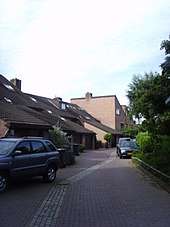Woonerf
A woonerf (Dutch pronunciation: [ˈʋoːnɛrf]) is a living street, as originally implemented in the Netherlands and in Flanders, the Dutch-speaking northern portion of Belgium. Techniques include shared space, traffic calming, and low speed limits. Under Article 44 of the Dutch traffic code, motorised traffic in a woonerf or "recreation area" is restricted to walking pace.[1]

The term "woonerf" has been adopted directly by some English-language publications. In the UK, these areas are called home zones. In the US, complete streets are a distinct concept where equal priority is given to all modes of transportation including automobiles, bicycles, and pedestrians, usually with separate rather than shared right-of-way.
Etymology
The word, of Dutch origin, literally translates as "living yard"[2] or "residential grounds".[3]
History

Since the invention of automobiles, cities have been predominantly constructed to accommodate the use of automobiles.[4]
The entire locality of Emmen in the Netherlands was designed as a woonerf in the 1970s.[5]
In 1999 the Netherlands had over 6000 woonerven[6] and today around 2 million Dutch people are living in woonerven.[7] The benefits of the woonerf are promoted by woonERFgoed, a network of professionals and residents.[8]
In 2006 it was reported that people in Hesselterbrink, a neighborhood of Emmen, were disillusioned about how the woonerf principle had become another traffic engineering measure that "entailed precious little more than signs and uniform standards". They have now encompassed the shared space principles as a way of rethinking the woonerf. They are reported to "now know that car drivers should become residents. Eye contact and human interaction are more effective means to achieve and maintain attractive and safe areas than signs and rules".[5] [9]
Notes
- Road Traffic Signs and Regulations in the Netherlands Ministerie van Verkeer en Waterstaat, June 2006 Accessed 7 February 2007.
- "Bicycle & Pedestrian Advisory Committee - Agenda - Wednesday, January 11, 2012" (PDF). Santa Clara Valley Transportation Authority. 11 January 2012. p. 2. Archived from the original (PDF) on September 10, 2013. Retrieved 25 August 2013.
- "Woonerf". Oxford Dictionaries. Oxford University Press. Retrieved 2015-07-13.
- MacPhee, Ian. "Is Vancouver ready for pedestrian priority streets?". re:place Magazine. Retrieved 29 March 2012.
- "Final evaluation by imma-san". Shared Space. 2006.
- Home Zones briefing sheet, Robert Huxford, Proceedings, Institution of Civil Engineers, Transport, 135, 45-46, February, 1999
- Sterke woonerfwijken: voorkomen is beter dan herstructureren, archived from the original on 2014-09-03
- The woonerfgoed network
Further reading
- Linda Baker (May 2004), "Why don't we do it in the road? A new school of traffic design says we should get rid of stop signs and red lights and let cars, bikes and people mingle together. It sounds insane, but it works.", Salon.com, archived from the original on 2012-01-27
- Paul Hockenos (April 26, 2013), "Where 'Share the Road' Is Taken Literally", The New York Times
- Paul Chasan, Traffic-Restricted Streets: Woonerfs and Transit Malls (PDF), University of Washington/Open Space Seattle 2100
- John Greenfield (June 30, 2014), "Woonerf in the West Suburbs Offers a Sneak Peek at Uptown Streetscapes", Streetsblog Chicago, OpenPlans (about a Batavia, Illinois woonerf)
External links
- Case Studies: Woonerf at California Active Transportation Safety Information Pages (UC Berkeley)
- What in the World is a Woonerf? (Canin Associates)